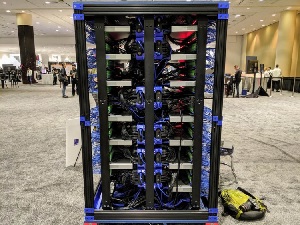



Date:18/09/19
 One Raspberry Pi can make a nice web server, but what happens if you put more than 1,000 of them together? At Oracle's OpenWorld convention on Monday, the company showed off a Raspberry Pi Supercomputer that combines 1,060 Raspberry Pis into one powerful cluster.
One Raspberry Pi can make a nice web server, but what happens if you put more than 1,000 of them together? At Oracle's OpenWorld convention on Monday, the company showed off a Raspberry Pi Supercomputer that combines 1,060 Raspberry Pis into one powerful cluster.
According to ServeTheHome, which first reported the story, the supercomputer features scores of racks with 21 Raspberry Pi 3 B+ boards each. To make everything run well together, the system runs on Oracle Autonomous Linux.
ServeTheHome asked Oracle why it chose to create a cluster of Raspberry Pis instead of using a virtualized Arm server and one company rep said simply that "...a big cluster is cool."
Oracle engineers connected the Raspberry Pis to a series of switches (Ubiquiti UniFi Switch 48s) and uplinked them with SFP+ 10GbE transceivers. The Raspberry Pis receive their power from a series of USB power supplies.
Every unit connects to a single rebranded Supermicro 1U Xeon server, which functions as a central storage server for the whole supercomputer. The Oracle team also created custom, 3D printed brackets to help support all the Pis and connecting components.
Raspberry Pi clusters aren't practical when it comes to performance, but the novelty of supercomputer projects often make the learning experience worthwhile. We don't expect this product to go commercial, but it is a really neat example of just how much you can do with a $35 computer.
Oracle built a supercomputer from 1000+ Raspberry Pis
 One Raspberry Pi can make a nice web server, but what happens if you put more than 1,000 of them together? At Oracle's OpenWorld convention on Monday, the company showed off a Raspberry Pi Supercomputer that combines 1,060 Raspberry Pis into one powerful cluster.
One Raspberry Pi can make a nice web server, but what happens if you put more than 1,000 of them together? At Oracle's OpenWorld convention on Monday, the company showed off a Raspberry Pi Supercomputer that combines 1,060 Raspberry Pis into one powerful cluster.According to ServeTheHome, which first reported the story, the supercomputer features scores of racks with 21 Raspberry Pi 3 B+ boards each. To make everything run well together, the system runs on Oracle Autonomous Linux.
ServeTheHome asked Oracle why it chose to create a cluster of Raspberry Pis instead of using a virtualized Arm server and one company rep said simply that "...a big cluster is cool."
Oracle engineers connected the Raspberry Pis to a series of switches (Ubiquiti UniFi Switch 48s) and uplinked them with SFP+ 10GbE transceivers. The Raspberry Pis receive their power from a series of USB power supplies.
Every unit connects to a single rebranded Supermicro 1U Xeon server, which functions as a central storage server for the whole supercomputer. The Oracle team also created custom, 3D printed brackets to help support all the Pis and connecting components.
Raspberry Pi clusters aren't practical when it comes to performance, but the novelty of supercomputer projects often make the learning experience worthwhile. We don't expect this product to go commercial, but it is a really neat example of just how much you can do with a $35 computer.
Views: 612
©ictnews.az. All rights reserved.Similar news
- The mobile sector continues its lead
- Facebook counted 600 million active users
- Cell phone testing laboratory is planned to be built in Azerbaijan
- Tablets and riders outfitted quickly with 3G/4G modems
- The number of digital TV channels will double to 24 units
- Tax proposal in China gets massive online feedback
- Malaysia to implement biometric system at all entry points
- Korea to build Green Technology Centre
- Cisco Poised to Help China Keep an Eye on Its Citizens
- 3G speed in Azerbaijan is higher than in UK
- Government of Canada Announces Investment in Green Innovation for Canada
- Electric cars in Azerbaijan
- Dominican Republic Govt Issues Cashless Benefits
- Spain raises €1.65bn from spectrum auction
- Camden Council boosts mobile security





















